A special highlight of my San Diego trip in February was a return visit to Hidden Agave Ranch. This 7½ acre hillside property north of Escondido is the home of agave wizard Jeremy Spath. Jeremy wears many hats: He owns a landscape design company, Water's Path; keeps sheep and alpacas for wool production (his wife, Grace, sells fiber products from their animals); and works on the cutting edge of agave breeding and hybridization. This includes operating his own tissue-culture lab in an outbuilding on his property.
 |
| Jeremy next to an Agave ovatifolia. Photo copyright © 2022 by Jeremy Spath. |
Looking like the quintessential Southern California beach dude, Jeremy radiates energy and never seems to stand still. Even with a crazy schedule, he finds time for regular trips to Mexico to study agaves in habitat. He typically flies out of Tijuana International Airport, which offers cheap flights to all major cities in Mexico. Jeremy says you can fly to Oaxaca and back for as little as $100. Tijuana's Cross Border Xpress (CBX) terminal has a 390-foot sky bridge which crosses the border and connects the airport with a parking lot on the U.S. side in San Diego's Otay Mesa neighborhood, making it very easy and convenient for travelers from the U.S.
In collaboration with Jeff Moore of Solana Succulents, Jeremy authored the most up-to-date and comprehensive book on agaves currently in print, Agaves: Species, Cultivars & Hybrids. Published in the fall of 2021, Agaves features more than 2,000 photos of 150+ species and dozens of hybrids and is a work of art in itself. You can buy the book from Jeremy or Jeff.
Jeremy and Jeff are already busy working on their next book, a groundbreaking survey of the genus Dudleya, to be published in 2023.
 |
| Agaves: Species, Cultivars & Hybrids by Jeremy Spath and Jeff Moore |
But back to Hidden Agave Ranch, Jeremy's playground in Escondido. Beyond sweeping views, the hilltop location is virtually frost-free because cold air flows down the hill. Jeremy says that he often sees frost on the valley floor, which makes it much more challenging for those homeowners to grow cold-sensitive succulents.
Jeremy and his family have only lived at Hidden Agave Ranch for four years, but the gardens look well established. With no hard freeze to contend with, there's nothing much that would slow plants down. In addition, the property has its own well so Jeremy is able to water more than he would if he were on municipal water. Depending on the area and the time of year, Jeremy irrigates his in-ground plantings 1–3 times a week.
Thanks to the extra water, Jeremy's agaves look as happy as can be. While most of them are in full sun, they don't appear stressed the way agaves left to their own devices often do. Jeremy's primary goal is to have beautiful plants, not to conduct survival experiments.
As you can imagine, Jeremy's garden contains a huge variety of agaves. While there are straight species, many of the plants are hybrids, some by other breeders like Kelly Griffin but most by Jeremy himself. The extent of Jeremy's hybridization work is breathtaking. My photos below only scratch the surface; Jeremy's Instagram page shows many other hybrids.
Let's start at the gate to Jeremy's realm:
 |
| The magic portal to Hidden Agave Ranch |
Agaves as far as the eyes can see, that pretty much sums up Jeremy's garden on the slope above his house. But these aren't common species or hybrids. Everyone is unique in one way or another. I was able to put names to some of them based on my previous visit, and Jeremy kindly provided IDs for the others.
 |
| Agave xylonacantha × potatorum |
 |
| Agave shawii × potatorum |
 |
| Superficially similar to the hybrid above, yet with completely different parentage: Agave pygmaea × bovicornuta |
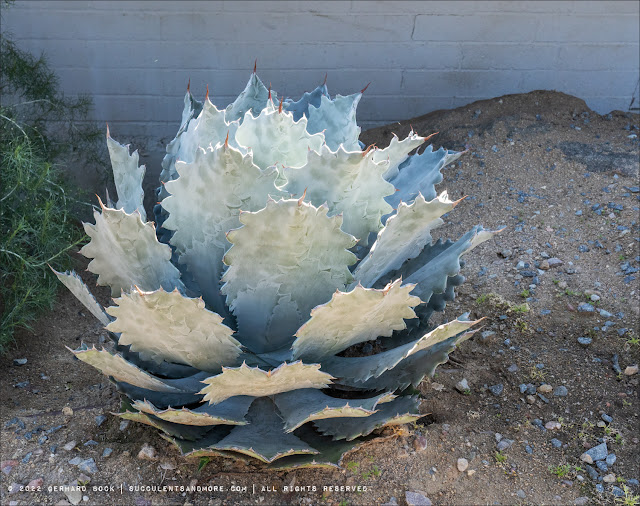 |
| Agave colorata × isthmensis, a hybrid created by Brian Kemble of the Ruth Bancroft Garden |
 |
| Agave pygmaea, not your common Agave pygmaea 'Dragon Toes' |
 |
| Agave 'Blue Flame' × mitis var. albidior |
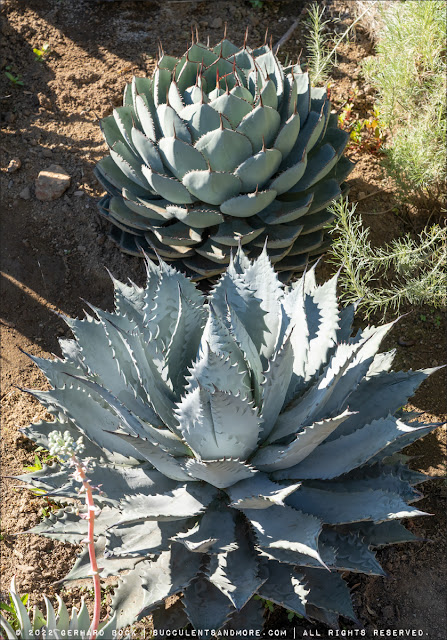 |
Top: Agave isthmensis 'Kichiokan' (wide leaf form)
Bottom: Agave colorata × utahensis var. nevadensis |
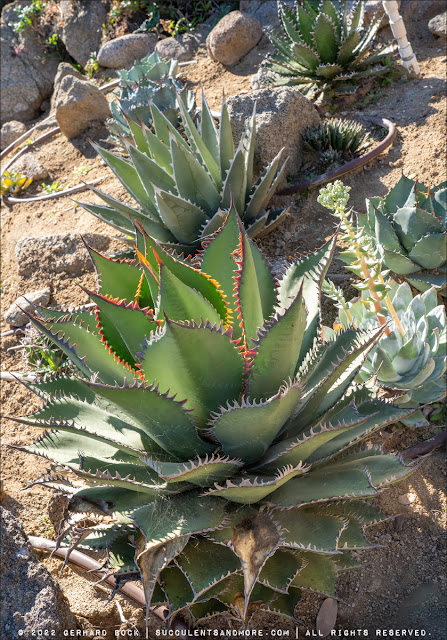 |
Agave shawii, one of two agave species native to San Diego County (the other being Agave deserti)
|
 |
| Agave shawii closeup |
 |
| Agave titanota |
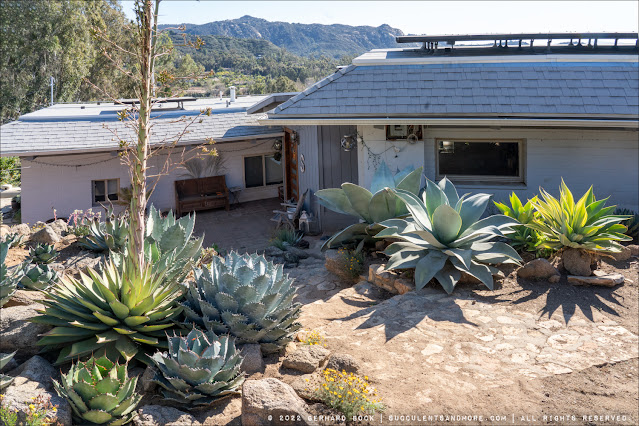 | | The flowering agave on the left is Agave 'Blue Glow' × margaritae |
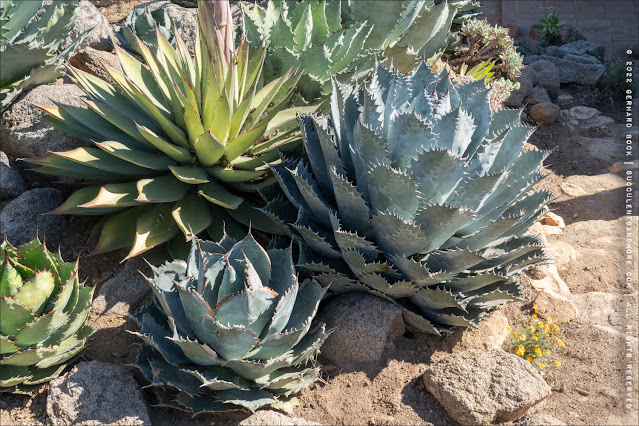 |
| Agave 'Blue Glow' × margaritae (top left, flowering), Agave parrasana (top right), Agave parrasana × isthmensis (bottom) |
 |
| Agave parrasana × isthmensis |
 |
| Agave parrasana × isthmensis with gnarly fused teeth |
 |
| Agave titanota |
 |
| Agave parrasana × isthmensis |
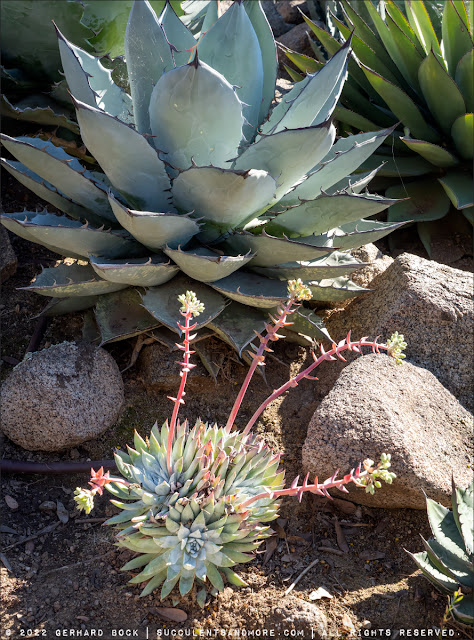 |
| Agave titanota × margaritae and Dudleya candida |
 |
| Dudleya gnoma |
 |
| Agave ellemeetiana × utahensis var. nevadensis (front) |
 |
| Agave attenuata (blue form) |
 |
| Panorama looking south |
 |
| The flowering agave is Agave seemaniana |
 |
| Agave seemanniana (left), Agave titanota (center), and an ever-blooming bougainvillea beyond |
 |
| Agave seemanniana (top), Agave ovatifolia × victoriae-reginae (left), Agave potatorum 'Spawn' × isthmensis (front) |
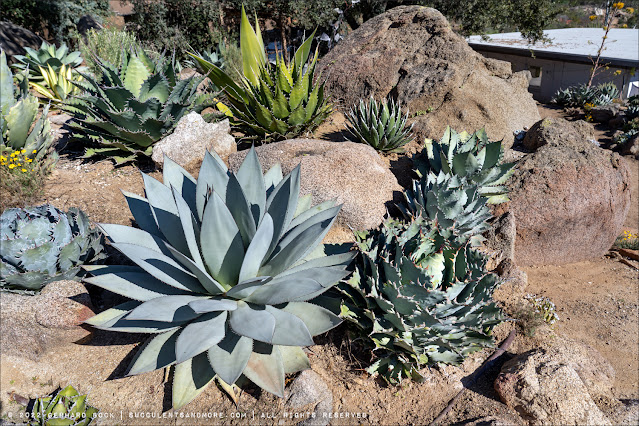 |
| Front left: Agave 'Blue Glow' × titanota, front right: Agave potatorum 'Spawn' × isthmensis |
 |
| In an agave garden this large and diverse, there's always something in flower |
 |
| Agave ocahui hybrid, essentially a bluer version of 'Blue Glow' |
 |
| Agave titanota × 'Blue Glow' |
 |
| Agave ovatifolia 'Orca' |
 |
| Variegated Agave attenuata |
 |
| Variegated Agave attenuata, with inflorescence from Agave isthmensis behind it. As you can see, Jeremy has been doing controlled pollination. |
 |
| Center: Agave horrida |
 |
| The big one center right is Agave chazaroi, one of my favorite agave species |
 |
| Another panoramic view down to the house |
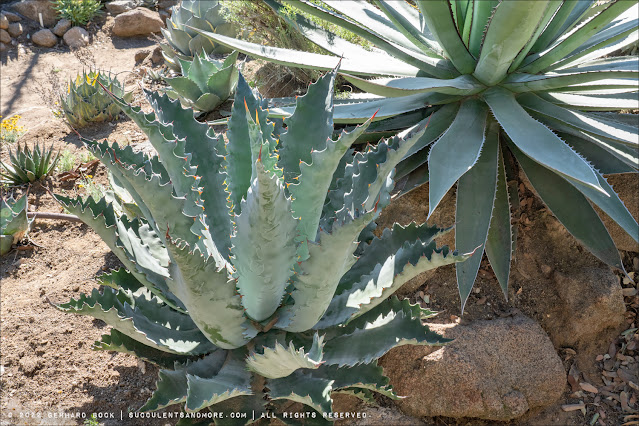 |
| Agave kristenii × potatorum, one of my favorite hybrids of Jeremy's |
When I visited Jeremy
in September 2020, dogweed (
Thymophylla pentachaeta) was in bloom throughout his garden. On this visit, in February 2022, the dogweed wasn't quite as exuberant, but there were still plenty of patches in flower. Based on my own (admittedly limited) experience, this wildflower native to the Southwestern U.S. and Mexico hardly ever takes a break, not even in winter.
 |
| Agave utahensis var. nevadensis × gypsophila |
Jeremy's 2,500 sq.ft. greenhouse is home to his personal collection as well as his seedlings and tissue-cultured agaves. The variety of plants is droolworthy—mostly agaves, of course, but also cycads, caudiciforms, terrestrial bromeliads, palms, etc. It would take a hundred photos of more to do it justice.
I only took a few photos inside the greenhouse because I was too busy listening to Jeremy so this is just a small sample of what there is to see.
 |
| Agave cupreata |
 |
Agave victoriae-reginae × guadalajarana
|
 |
| Another Agave victoriae-reginae × guadalajarana |
 |
| Agave shawii × isthmensis |
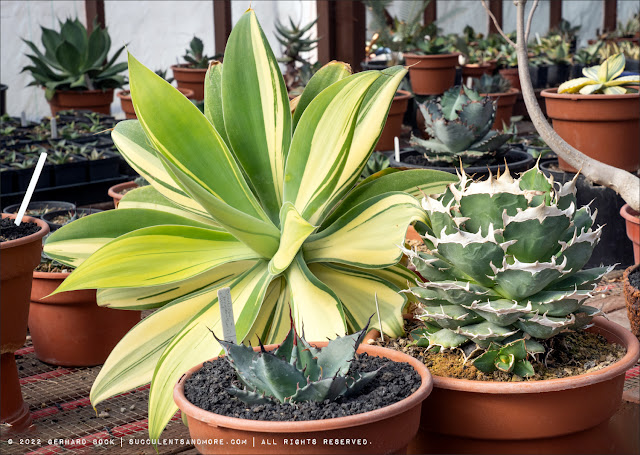 |
| Wildly streaked Agave attenuata and a beautifully stacked Agave oteroi |
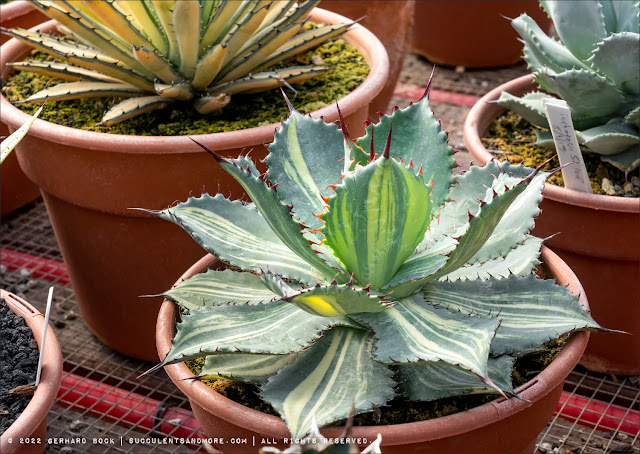 |
| Agave bovicornuta × pygmaea |
 |
| Agave utahensis var. eborispina |
 |
| Toothless Agave colorata |
 |
| Agave margaritae |
 |
| Agave colorata × utahensis var. nevadensis |
 |
| Agave seedlings cheek to jowl in a 6" pot |
 |
| Agave albescens, native to Guantánamo Bay in Cuba and rare in cultivation in the U.S. More info here. Hardiness is not known, but I doubt it'll do well much below freezing. |
Jeremy sells both agave hybrids and seed-grown species on his web site,
HiddenAgave.com. New introductions often sell out quickly. If you want to choose from a bigger selection and pick out your own plants, you can
make an appointment to visit Hidden Agave Ranch in person.
—————
Hunter of Cactus Quest made a very thoughtful 16-minute video about Jeremy. It features conversations with Jeremy about his personal journey, shows drone footage inside the greenhouse, and documents a field trip Hunter and Jeremy took to the California–Nevada border to look at Agave utahensis var. eborispina in habitat. The video also touches on plant poaching and conservation, and the role growers can play in reducing the pressure on plants in the wild.
RELATED POSTS:
© Gerhard Bock, 2022. All rights reserved. To receive all new posts by email, please subscribe here.


















































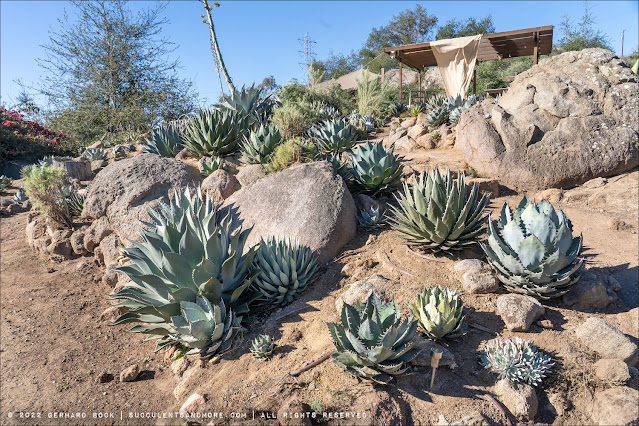




For an agave fan, this home garden must feel like heaven. Even a lay person such as myself can appreciate the dedication, enthusiasm and vastness of this collection. The greenhouse is a fantastic space that looks like a museum worthy of a long exploratory visit.
ReplyDeleteThe next time I'll bring my tripod so I can take better photos inside the greenhouse!
DeleteMy head is about to explode. I can't even begin to comprehend the quantity of different agave crosses Jeremy has in his garden. While I would love to visit I also don't know that I'd be able to leave.
ReplyDeleteIt's like being in a museum. Eventually you reach overdrive, and your brain starts to shut down :-)
DeleteI can't even imagine the challenge of keeping the parentage of these agaves straight, much less the work that obviously went into the hybridizing process. All the specimens you photographed look perfect. I'm impressed by your ability to put a name to each plant too.
ReplyDeleteJeremy was a big help providing IDs. As I said to him, it's pointless guessing what something is.
DeleteCrazy to contemplate picking a favorite, but that Agave victoriae-reginae × guadalajarana really caught my eye, as does bovicornuta x pygmaea. A neighbor was just telling me about his preference for using the TJ airport to get to destinations in Mexico, and he says a lux hotel room for an overnight in TJ comes cheap too. So glad you're such an intrepid agave reporter, Gerhard!
ReplyDeleteSomebody else told me about that sky bridge to the TJ airport. I want to go exploring in Mexico!!
DeleteSo what did you buy??
ReplyDeleteI'm working on a plant haul post, but here's what I got from Jeremy:
DeleteAgave isthmensis 'Kichiokan', wide-leaf from (here)
Agave shawii × isthmensis (here)
Agave shawii × parrasana (here)
Hechtia lanata
Others I was interested in weren't ready yet.
Agave lover's heaven! With a water well!!
ReplyDeleteThe word well has never sounded so sweet!
DeleteWhat a place ! Even his Dudleyas look good. I'm off to watch the video.
ReplyDeleteMy god, it's agave heaven. Every single plant looks like its best version of itself! Thanks for showing us, Gerhard.
ReplyDeleteI also bought Agave shawii × isthmensis from Jeremy last summer. I just love the dental work on the edges! What a terrific grower he is.
ReplyDeleteDo you sell a small Agave parrasana × isthmensis with gnarly fused teeth? And how much do you ask? Blue kelp forest@gmail.com
ReplyDeleteSorry, but I don't sell plants.
Delete